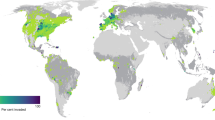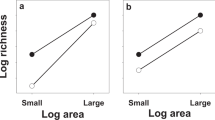Abstract
Community assembly through species invasions is a long-term process, for which vital information regarding future trends can be contained in current patterns. Using comparative analyses of native and exotic plant assemblages from meadow patches on islands in British Columbia, Canada, we examined multiple lines of evidence for ‘invasion debt’, a latent expansion of exotic species populations. We show that: (1) short-dispersing species are underrepresented compared to their long-dispersing counterparts in exotic species only; (2) among species that are invasive elsewhere in North America, a greater proportion of long dispersers are common in the study area and a greater proportion of short dispersers are rare; and (3) time since arrival in the study region is positively related to number of occurrences in exotic species. In addition, we show that a suite of exotic species possesses the facility of rapid long-distance dispersal and ability to establish viable populations on even the most isolated and least disturbed patches. While some highly-dispersive exotic species can rapidly colonize new areas, short dispersers appear to exhibit invasion debt, with their potential distributions only being realized in the long term. Removing or even reducing populations of many rapid colonizers could be extremely difficult; however, for species exhibiting patterns most consistent with invasion debt, an opportunity exists for monitoring and removal to help reduce potential competition with native species.


Similar content being viewed by others
References
Ahern RG, Landis DA, Reznicek AA, Schemske DW (2010) Spread of exotic plants in the landscape: the role of time, growth habit, and history of invasiveness. Biol Invasions 12:3157–3169
Bjorkman AD, Vellend M (2010) Defining historical baselines for conservation: ecological changes since European settlement on Vancouver Island, Canada. Conserv Biol 24:1559–1568
Cadotte MW, Borer ET, Seabloom EW, Cavender-Bares J, Harpole WS, Cleland E, Davies KF (2010) Phylogenetic patterns differ for native and exotic plant communities across a richness gradient in Northern California. Divers Distrib 16:892–901
Callaway RM, Aschehoug ET (2000) Invasive plants versus their new and old neighbors: a mechanism for exotic invasion. Science 290:521–523
Canadian Climate Change Scenarios Network (CCCSN) (2010) Canadian Climate Change Scenarios Network—Visualization. http://cccsn.ca/?page=scen-viz. Accessed Jan 2011
Daehler CC (2003) Performance comparisons of co-occurring native and alien invasive plants: implications for conservation and restoration. Ann Rev Ecol Evol Syst 34:183–211
Daleo P, Alberti J, Iribarne O (2009) Biological invasions and the neutral theory. Divers Distrib 15:547–553
Davis MA, Grime JP, Thompson K (2000) Fluctuating resources in plant communities: a general theory of invasibility. J Ecol 88:528–534
Douglas GW, Straley GB, Meidinger DV, Pojar J (1998–2002) Illustrated Flora of British Columbia, 8 vols. BC Ministry of Sustainable Resource Management and BC Ministry of Forests, Victoria
Emery SH (2007) Limiting similarity between invaders and dominant species in herbaceous plant communities? J Ecol 95:1027–1035
Essl F, Dullinger S, Rabitsch W, Hulme PE, Hülber K, Jarošíke V, Kleinbauer I, Krausmann F, Kühn I, Nentwig W, Vilà M, Genovesi P, Gherardi F, Desprez-Loustau M-L, Roques A, Pyšek P (2011) Socioeconomic legacy yields an invasion debt. Proc Natl Acad Sci USA 108:203–207
Fuchs MA (2001) Towards a recovery strategy for garry oak and associated ecosystems in Canada: ecological assessment and literature review. Canadian Wildlife Service, Technical Report EC/GB-00-030
Gonzales EK, Arcese P (2008) Herbivory more limiting than competition on early and established native plants in an invaded meadow. Ecology 89:3282–3289
Harvey PH, Read AF, Nee S (1995) Why ecologists need to be phylogenetically challenged. J Ecol 83:535–536
Leishman MR, Thomson VP, Cook J (2010) Native and exotic invasive plants have fundamentally similar carbon capture strategies. J Ecol 89:3282–3289
Lilley PL, Vellend M (2009) Negative native–exotic diversity relationship in oak savannas explained by human influence and climate. Oikos 118:1373–1382
Lloret F, Médail F, Brundu G, Hulme PE (2004) Local and regional abundance of exotic plant species on Mediterranean islands: are species traits important? Glob Ecol Biogeogr 13:37–45
MacDougall AS (2005) Responses of diversity and invasibility to burning in a northern oak savanna. Ecology 86:3354–3363
MacDougall AS, Turkington R (2005) Are invasive species the drivers or passengers of change in degraded ecosystems? Ecology 86:42–55
MacDougall AS, Turkington R (2006) Dispersal, competition, and shifting patterns of diversity in a degraded oak savanna. Ecology 87:1831–1843
MacDougall AS, Beckwith BR, Maslovat CY (2004) Defining conservation strategies with historical perspectives: a case study from a degraded oak grassland ecosystem. Conserv Biol 18:455–465
Mack RN (2003) Plant naturalizations and invasions in the eastern United States: 1634–1860. Ann Mo Bot Gard 90:77–90
Pellatt MG, Hebda RJ, Mathewes RW (2001) High-resolution Holocene vegetation history and climate from Hole 1034B, ODP leg 169S, Saanich Inlet, Canada. Mar Geol 174:211–226
R Development Core Team (2010) R: A language and environment for statistical computing. R Foundation for Statistical Computing, Vienna, Austria. http://www.R-project.org
Rabinowitz D (1981) Seven forms of rarity. In: Synge H (ed) The biological aspects of rare plant conservation. Wiley, New York, pp 205–217
Reichard SH, White P (2001) Horticulture as a pathway of invasive plant introductions in the United States. Bioscience 51:103–113
Seabloom EW, Williams JW, Slayback D, Stoms DM, Viers JH, Dobson AP (2006) Human impacts, plant invasion, and imperiled plant species in California. Ecol Appl 16:1338–1350
Shea K, Chesson P (2002) Community ecology theory as a framework for biological invasions. Trends Ecol Evol 17:170–176
Strayer DL, Eviner VT, Jeschke JM, Pace ML (2006) Understanding the long-term effects of species invasions. Trends Ecol Evol 21:645–651
van Kleunen ME, Weber E, Fischer M (2010) A meta-analysis of trait differences between invasive and non-invasive plant species. Ecol Lett 13:235–245
Vilà M, Pino J, Font X (2007) Regional assessment of plant invasions across different habitat types. J Veg Sci 18:35–42
Williamson M, Dehnen-Schmutz K, Kühn I, Hill M, Klotz S, Milbau A, Stout J, Pyšek P (2009) The distribution of range sizes of native and alien plants in four European countries and the effects of residence time. Divers Distrib 15:158–166
Acknowledgments
This work was supported by grants from the Natural Sciences and Engineering Research Council of Canada (NSERC) to MV and PA, NSERC Canada Graduate Scholarships to JRB and PLL, the UBC Biodiversity Centre Postdoctoral Fellowship to WKC, and the UBC Faculty of Forestry. We thank A. MacDougall and two anonymous reviewers for helpful comments on an earlier version of this paper.
Author information
Authors and Affiliations
Corresponding author
Electronic supplementary material
Below is the link to the electronic supplementary material.
Rights and permissions
About this article
Cite this article
Bennett, J.R., Vellend, M., Lilley, P.L. et al. Abundance, rarity and invasion debt among exotic species in a patchy ecosystem. Biol Invasions 15, 707–716 (2013). https://doi.org/10.1007/s10530-012-0320-z
Received:
Accepted:
Published:
Issue Date:
DOI: https://doi.org/10.1007/s10530-012-0320-z




